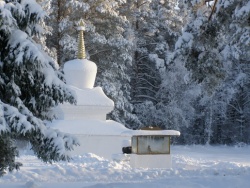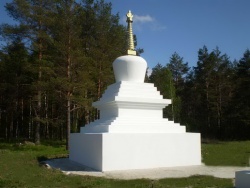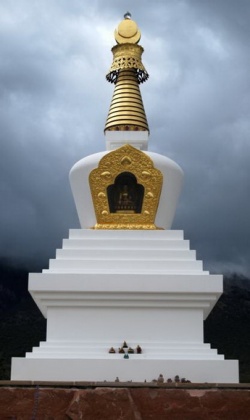Visualisation of the Six-Element Stūpa
There are several practices connected with the Elements in Buddhist tradition. For instance, there is a section on the four elements in the body awareness portion of the Satipatthana Sutta, the primary teaching on mindfulness. One that I have found to be very effective is the visualization of the six-element stupa. This employs simple images similarly to the kasina meditations. Various forms of the Buddhist stupa are well known from Nepal to Japan. They were originally monuments for holding remains of Buddhas or other saints, and are often honoured by circumambulation as though they themselves are actually Buddhas.
The stupa represents the six elements because they are what you were produced from at birth and what are given up at death. The classic stupa consists of six symbols representing the elements assembled vertically from ground level, with the symbol for earth and the other elements arranged above one another in order of subtlety. Occasionally only four, or even just two, elements are represented.
The Buddha is said to have designed the first stupa in the simplest possible form. Asked what kind of burial mound would be appropriate after his death, he silently folded a yellow robe into a cube shape, placed it on the ground and laid upon it his upturned begging bowl. So the yellow cube symbolizes earth. Square shapes express some of the qualities of earth: solidity, strength, support and so on. As you visualize this, you are not required to get a clear, stable picture; you need only get a sense of the symbol’s earthy quality – some feeling, sensation or other impression that enables you to dwell easily on the earth element. Use direct sense experience as well, noticing, for example, the solid floor supporting you or the hardness of your teeth and nails.
Then, above the cube, imagine the water element, represented by a white dome or a globe like the full moon. The water element certainly expresses the quality of flowing, but then fire and air also flow. The distinctive elemental character of water is its cohesion. So the white sphere is like a bubble or a drop of water that in nature holds together as though by magic. To engage more with the water element, notice the wetness of your eyes and tongue – and also swallow, triggering an experience of the liquid nature throughout the body. Getting more deeply involved with the elements can be unusually satisfying, and there is perhaps some relief in being able to acknowledge a level of experience that is present in everyone before they are even born. You were intimate with the elements well before you were self-aware.
The energy of earth is stable and unmoving; the holding energy of water moves only inwards and downwards. With the fire element, the energy radiates only outwards and upwards. Fire is symbolized by a bright red cone, rather like a flame. As you allow this new form and its colour to influence you, the qualities of temperature and light in your present experience become clearer. Notice, for example, that your eyes are actually receiving light and that your body is warm.
Above that, the symbolic element of wind or air is a pale green dish shape, delicate like porcelain. At least that is how I imagine it. You are free to play around with these forms. They can be lively and even comical. I see wind like a sensitive satellite dish, picking up sensations and vibrating with them, or like a pale green frisbee juddering as it skims through space.
The air element is not about air as a gas; here ‘air’ is a symbol for movement. Thus the alternative term is ‘wind’ (Sanskrit: vāyu), which expresses that essential moving characteristic as found in the pulsing of the blood, the tidal flow of breathing and the progressive relaxation of the muscles as the body stills in meditation posture. In deep meditation, the movements within the body’s subtle energy channels become apparent. These are known as winds (lung); and if you watch very closely and gently, the play of thoughts and emotions is sometimes observable in particular parts of the body, riding as though upon flowing breezes. Everything that exists, inside and outside, not only has movement but also often moves in different ways at the same time. Even if something could be completely solid and stable, which is impossible, it would still be moving, for the planet itself is moving in several ways. Thus the element air spreads out simultaneously in all directions.
No movement, temperature, coherency or stable matter can exist without space to contain it. The element of space is symbolized by a single point, a ‘drop’ that is gently flaming, showing its vibrant living quality. Elemental space is not a vacuum. The single point symbolizes the fact that space is everywhere all at once: it is infinitely out there and is also infinitely ‘in here’, in the endless microspaces in the body. Notice how distinctly (and also how emotionally) you are sometimes aware of the particular location of various parts of your body. Everything has to take place somewhere. So this ‘flaming jewel drop’, as it is sometimes called, stands for the fact that this space here is one of an infinite number of possible points.
Finally, the element of consciousness or awareness is the ‘space’ within which space itself happens. This is not to imply the solipsism that ‘it’s all in the mind’ but to offer the simple reminder that whatever the ultimate truth may be, earth, water, fire, movement and space are all experienced by the mind. So you can call this the element of ‘experience’. Philosophical questions about whether or not the elements take place outside experience and exactly how they might are interesting to contemplate but they are not relevant here. This creates a rare and precious opportunity to dwell on the experience of experiencing itself. Is this sensation ‘me’ or is it ‘mine’ – or what is its nature otherwise? This most basic of all the elements is symbolized by an open sky, which is clear, blue and boundless.
In fact, the practice begins here. Start with the blue sky and let it contain, in order one by one, the symbols for earth, water, fire, wind and space. The stupa of the elements, surrounded by clear blue sky, symbolizes your entire experience and response to a world filled with many sensations of resistance, cohesiveness, temperature and movement in space. As you connect with each element through its symbol, experience its special qualities directly in the body as much as you can; appreciate its particular life-energy, its role in your existence. Once the connection is there, you reflect that despite your habitual attitudes, this characteristic of your body experience is not something that you can possibly own in any literal way. Its nature is completely free, and you can let go fully into that quality of freedom. For that letting go to be meaningful, you need to acknowledge and to feel the particular ways you grasp experiences and sensations as ‘me’ or ‘mine’. These may not be obvious at first. In the end, the practice requires a commitment to the deepest reflection and a genuine desire to enquire into what really happens in the thoughts and feelings you have about yourself and the world. This will come in time if you want it to – depth and skill comes from applying these reflections in a sustained way.
Ending the practice is done in a special way, to reflect that profound process of letting go. Just as they were conjured up in the blue sky of awareness, now the elemental symbols all dissolve back into it. In turn from the top, each symbolic form melts and dissolves into the element beneath: the space element melts down and is absorbed into the wind element, then wind melts into fire, fire into water and water into earth. The earth element melts into the sky. The sky itself dissolves like mist, and gradually you return once more to the direct experience of the six elements as again and again they emerge, solidify and dissolve in the course of daily life.
If pursued, this meditation will develop real, living connections to the elements and with nature generally, helping you to live more ethically and in harmony with the earth. If you want, it can become a special eco-Dharma practice. All Buddhist meditation methods can have this kind of effect, since all of them include mindfulness of the physical body. The same feeling of harmony arises as you engage with other Buddhist methods such as ethics, wisdom, right livelihood, study and community. It is not surprising that the stupa is held in such high honour in the East, representing as it does both the wonders of the natural world and the amazing nature of the Buddha which can be awakened in all of us.


